ZHCSG03A December 2016 – January 2017 TPS54260-EP
PRODUCTION DATA.
- 1 特性
- 2 应用范围
- 3 说明
- 4 修订历史记录
- 5 Pin Configuration and Functions
- 6 Specifications
-
7 Detailed Description
- 7.1 Overview
- 7.2 Functional Block Diagram
- 7.3
Feature Description
- 7.3.1 Fixed Frequency PWM Control
- 7.3.2 Slope Compensation Output Current
- 7.3.3 Pulse Skip Eco-mode Control Scheme
- 7.3.4 Low Dropout Operation and Bootstrap Voltage (Boot)
- 7.3.5 Error Amplifier
- 7.3.6 Voltage Reference
- 7.3.7 Adjusting the Output Voltage
- 7.3.8 Enable and Adjusting Undervoltage Lockout (UVLO)
- 7.3.9 Slow-Start and Tracking Pin (SS/TR)
- 7.3.10 Overload Recovery Circuit
- 7.3.11 Constant Switching Frequency and Timing Resistor (RT and CLK Pin)
- 7.3.12 Overcurrent Protection and Frequency Shift
- 7.3.13 Selecting the Switching Frequency
- 7.3.14 How to Interface to RT/CLK Pin
- 7.3.15 Power Good (PWRGDPin)
- 7.3.16 Overvoltage Transient Protection (OVTP)
- 7.3.17 Thermal Shutdown
- 7.3.18 Small Signal Model for Loop Response
- 7.3.19 Simple Small-Signal Model for Peak Current Mode Control
- 7.3.20 Small-Signal Model for Frequency Compensation
- 7.4 Device Functional Modes
-
8 Application and Implementation
- 8.1 Application Information
- 8.2
Typical Application
- 8.2.1 Design Requirements
- 8.2.2
Detailed Design Procedure
- 8.2.2.1 Selecting The Switching Frequency
- 8.2.2.2 Output Inductor Selection (LO)
- 8.2.2.3 Output Capacitor
- 8.2.2.4 Catch Diode
- 8.2.2.5 Input Capacitor
- 8.2.2.6 Slow-Start Capacitor
- 8.2.2.7 Bootstrap Capacitor Selection
- 8.2.2.8 UVLO Set Point
- 8.2.2.9 Output Voltage and Feedback Resistors Selection
- 8.2.2.10 Compensation
- 8.2.2.11 Discontinuous Mode and Eco-mode Control Scheme Boundary
- 8.2.2.12 Power Dissipation
- 8.2.3 Application Curves
- 9 Power Supply Recommendations
- 10Layout
- 11器件和文档支持
- 12机械、封装和可订购信息
封装选项
机械数据 (封装 | 引脚)
散热焊盘机械数据 (封装 | 引脚)
订购信息
6 Specifications
6.1 Absolute Maximum Ratings
over operating temperature range (unless otherwise noted).(1)| MIN | MAX | UNIT | ||||
|---|---|---|---|---|---|---|
| Input voltage | VIN | –0.3 | 65 | V | ||
| EN(2) | –0.3 | 5 | ||||
| VSENSE | –0.3 | 3 | ||||
| COMP | –0.3 | 3 | ||||
| PWRGD | –0.3 | 6 | ||||
| SS/TR | –0.3 | 3 | ||||
| RT/CLK | –0.3 | 3.6 | ||||
| Output voltage | BOOT-PH | –0.3 | 8 | V | ||
| PH | –0.6 | 65 | ||||
| 200 ns | –1 | 65 | ||||
| 30 ns | –2 | 65 | ||||
| Maximum dc voltage, T J= –40°C | –0.85 | |||||
| Voltage difference | PAD to GND | ±200 | mV | |||
| Source current | EN | 100 | μA | |||
| BOOT | 100 | mA | ||||
| VSENSE | 10 | μA | ||||
| PH | Current limit | |||||
| RT/CLK | 100 | μA | ||||
| Sink current | VIN | Current limit | ||||
| COMP | 100 | μA | ||||
| PWRGD | 10 | mA | ||||
| SS/TR | 200 | μA | ||||
| Operating junction temperature | –55 | 150 | °C | |||
| Storage temperature, Tstg | –65 | 150 | °C | |||
(1) Stresses beyond those listed under Absolute Maximum Ratings may cause permanent damage to the device. These are stress ratings only, which do not imply functional operation of the device at these or any other conditions beyond those indicated under Recommended Operating Conditions. Exposure to absolute-maximum-rated conditions for extended periods may affect device reliability.
(2) See Enable and Adjusting Undervoltage Lockout (UVLO) for details.
6.2 ESD Ratings
| VALUE | UNIT | |||||
|---|---|---|---|---|---|---|
| V(ESD) | Electrostatic discharge | Human-body model (HBM), per ANSI/ESDA/JEDEC JS-001(1) | ±2000 | V | ||
| Charged-device model (CDM), per JEDEC specification JESD22-C101(2) | ±500 | |||||
(1) JEDEC document JEP155 states that 500-V HBM allows safe manufacturing with a standard ESD control process.
(2) JEDEC document JEP157 states that 250-V CDM allows safe manufacturing with a standard ESD control process.
6.3 Recommended Operating Conditions
over operating junction temperature range (unless otherwise noted)| MIN | NOM | MAX | UNIT | ||
|---|---|---|---|---|---|
| TJ | Operating junction temperature | –55 | 150 | °C | |
6.4 Thermal Information
| THERMAL METRIC(1)(2) | TPS54260-EP | UNIT | |||
|---|---|---|---|---|---|
| DRC (VSON) | DGQ (HVSSOP) | ||||
| 10 PINS | 10 PINS | ||||
| RθJA | Junction-to-ambient thermal resistance | Standard board | 40 | 62.5 | °C/W |
| Custom board(3) | — | 57 | |||
| RθJC(top) | Junction-to-case (top) thermal resistance | 65 | 83 | °C/W | |
| RθJB | Junction-to-board thermal resistance | 8 | 28 | °C/W | |
| ψJT | Junction-to-top characterization parameter | 0.6 | 1.7 | °C/W | |
| ψJB | Junction-to-board characterization parameter | 7.5 | 20.1 | °C/W | |
| RθJC(bot) | Junction-to-case (bottom) thermal resistance | 7.8 | 21 | °C/W | |
(1) For more information about traditional and new thermal metrics, see the Semiconductor and IC Package Thermal Metrics application report.
(2) Power rating at a specific ambient temperature TA should be determined with a junction temperature of 150°C. This is the point where distortion starts to substantially increase. See power dissipation estimate in application section of this data sheet for more information.
(3) Test boards conditions:
- 3 in × 3 in, 2 layers, thickness: 0.062 in.
- 2-oz copper traces located on the top of the PCB.
- 2-oz copper ground plane, bottom layer.
- 6-thermal vias (13 mil) located under the device package.
6.5 Electrical Characteristics
TJ = –55 to 150°C, VIN = 3.5 to 60 V (unless otherwise noted)| PARAMETER | TEST CONDITIONS | MIN | TYP | MAX | UNIT | ||
|---|---|---|---|---|---|---|---|
| SUPPLY VOLTAGE (VIN PIN) | |||||||
| Operating input voltage | 3.5 | 60 | V | ||||
| Internal undervoltage lockout threshold | No voltage hysteresis, rising and falling | 2.5 | V | ||||
| Shutdown supply current | EN = 0 V, 3.5 V ≤ VIN ≤ 60 V | 1.3 | 10 | μA | |||
| Operating: nonswitching supply current | VSENSE = 0.83 V, VIN = 12 V | 138 | 200 | μA | |||
| ENABLE AND UVLO (EN PIN) | |||||||
| Enable threshold voltage | No voltage hysteresis, rising and falling, 25°C | 1.14 | 1.25 | 1.36 | V | ||
| Input current | Enable threshold +50 mV | –3.8 | μA | ||||
| Enable threshold –50 mV | –0.9 | ||||||
| Hysteresis current | –2.9 | μA | |||||
| VOLTAGE REFERENCE | |||||||
| Voltage reference | TJ = 25°C | 0.792 | 0.8 | 0.808 | V | ||
| 0.78 | 0.8 | 0.82 | |||||
| HIGH-SIDE MOSFET | |||||||
| on resistance | VIN = 3.5 V, BOOT-PH = 3 V | 300 | mΩ | ||||
| VIN = 12 V, BOOT-PH = 6 V | 200 | 410 | |||||
| ERROR AMPLIFIER | |||||||
| Input current | 50 | nA | |||||
| Error amplifier transconductance (gM) | –2 μA < ICOMP < 2 μA, VCOMP = 1 V | 310 | μS | ||||
| Error amplifier transconductance (gM) during slow-start | –2 μA < ICOMP < 2 μA, VCOMP = 1 V, VVSENSE = 0.4 V |
70 | μS | ||||
| Error amplifier dc gain | VVSENSE = 0.8 V | 10,000 | V/V | ||||
| Error amplifier bandwidth | 2700 | kHz | |||||
| Error amplifier source/sink | V(COMP) = 1 V, 100 mV overdrive | ±27 | μA | ||||
| COMP to switch current transconductance | 10.5 | A/V | |||||
| CURRENT LIMIT | |||||||
| Current limit threshold | VIN = 12 V | 3.5 | 6.1 | A | |||
| THERMAL SHUTDOWN | |||||||
| Thermal shutdown | 182 | °C | |||||
| TIMING RESISTOR AND EXTERNAL CLOCK (RT/CLK PIN) | |||||||
| Switching frequency range using RT mode | 100 | 2500 | kHz | ||||
| fSW | Switching frequency | RT = 200 kΩ | 450 | 581 | 720 | kHz | |
| Switching frequency range using CLK mode | 300 | 2200 | kHz | ||||
| Minimum CLK input pulse width | 40 | ns | |||||
| RT/CLK high threshold | 1.9 | 2.2 | V | ||||
| RT/CLK low threshold | 0.5 | 0.7 | V | ||||
| RT/CLK falling edge to PH rising edge delay | Measured at 500 kHz with RT resistor in series | 60 | ns | ||||
| PLL lock in time | Measured at 500 kHz | 100 | μs | ||||
| SLOW-START AND TRACKING (SS/TR) | |||||||
| Charge current | VSS/TR = 0.4 V | 2 | μA | ||||
| SS/TR-to-VSENSE matching | VSS/TR = 0.4 V | 45 | mV | ||||
| SS/TR-to-reference crossover | 98% nominal | 1.15 | V | ||||
| SS/TR discharge current (overload) | VSENSE = 0 V, V(SS/TR) = 0.4 V | 382 | μA | ||||
| SS/TR discharge voltage | VSENSE = 0 V | 54 | mV | ||||
| POWER GOOD (PWRGD PIN) | |||||||
| VVSENSE | VSENSE threshold | VSENSE falling | 92% | ||||
| VSENSE rising | 94% | ||||||
| VSENSE rising | 109% | ||||||
| VSENSE falling | 107% | ||||||
| Hysteresis | VSENSE falling | 2% | |||||
| Output high leakage | VSENSE = VREF, V(PWRGD) = 5.5 V, 25°C | 10 | nA | ||||
| On resistance | I(PWRGD) = 3 mA, VSENSE < 0.79 V | 50 | Ω | ||||
| Minimum VIN for defined output | V(PWRGD) < 0.5 V, II(PWRGD) = 100 μA | 0.95 | 1.9 | V | |||
6.6 Typical Characteristics
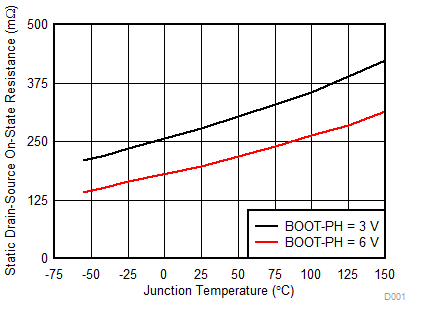
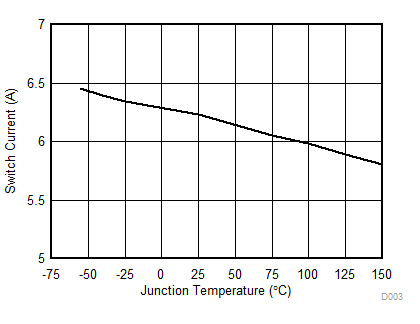
| VI = 12 V | ||
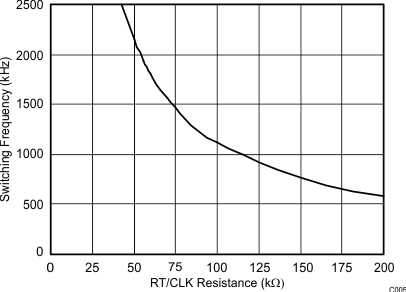
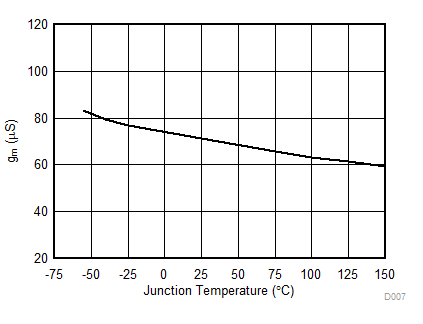
| VI = 12 V | ||
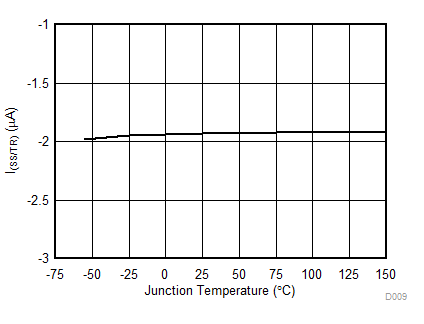
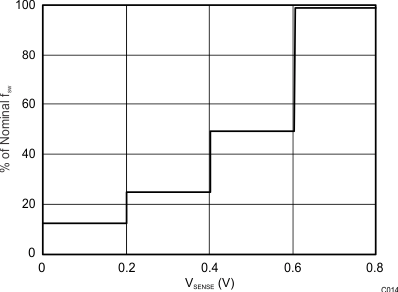
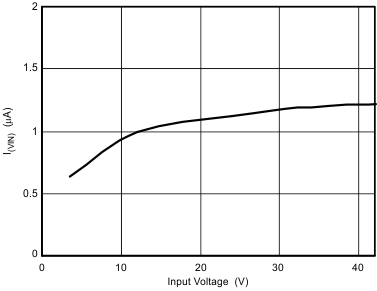
| TJ = 25°C | ||
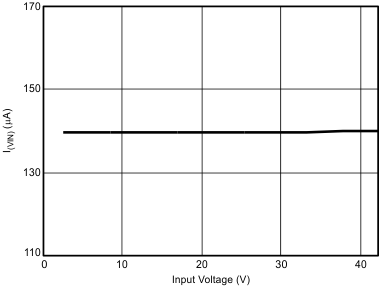
| TJ = 25°C | VI(VSENSE) = 0.83 V | |
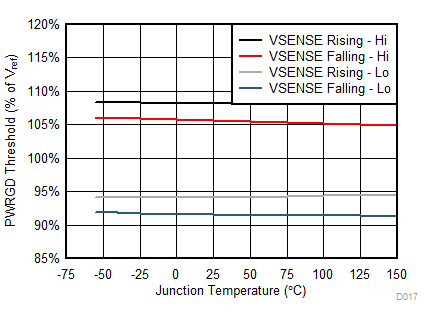
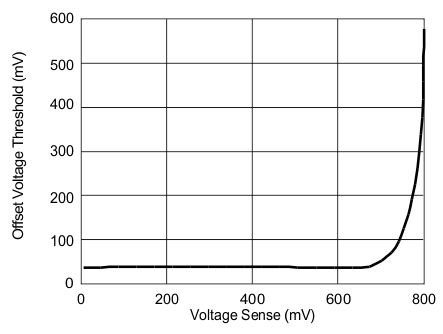
| TJ = 25°C | VI = 12 V | |
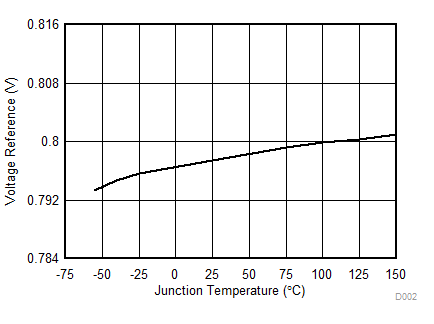


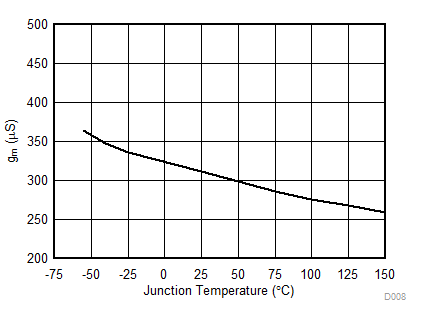
| VI = 12 V | ||
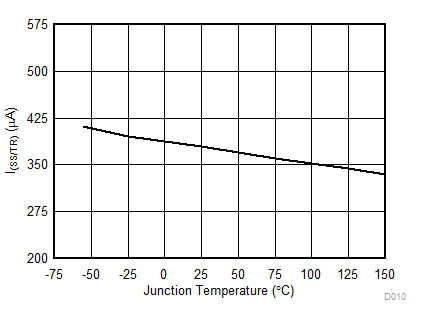
| VI = 12 V | ||
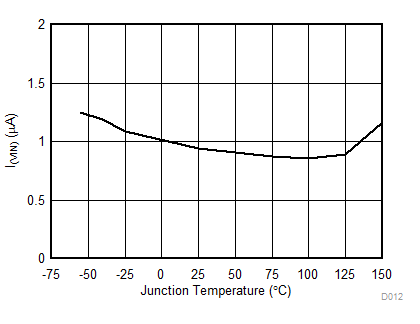
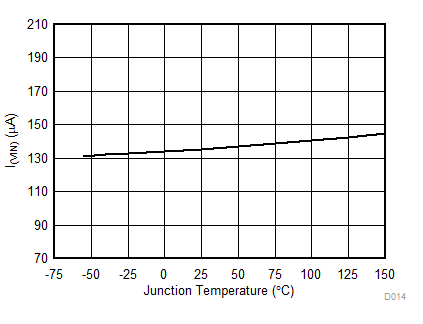
| VI = 12 V | VI(VSENSE) = 0.83 V | |

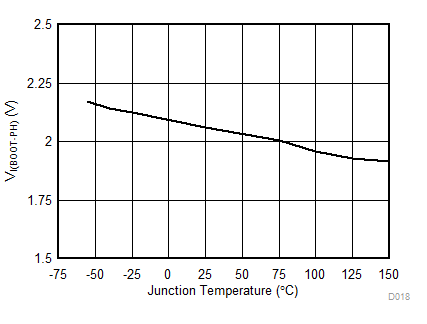
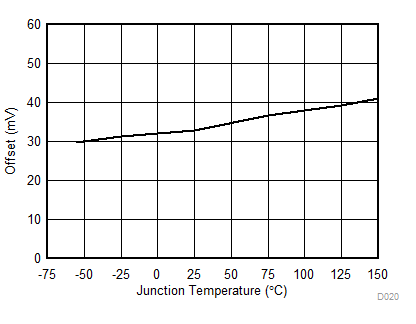
| VI = 12 V | V(SS/TR) = 0.4 V | |